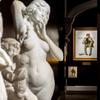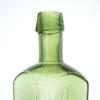Au Naturel: The Art of the Female Form at M.S. Rau
- April 07, 2022 07:47
M.S. Rau is pleased to announce the opening of Au Naturel: The Art of the Female Form, an exhibition that explores the prolific and ever-alluring subject of the nude through over four hundred years of fine art. The show is a contemplation on the themes that have defined and redefined the nude over the centuries. Since antiquity, she has been depicted as mother, wife, lover and goddess, existing in both mythical worlds and domestic realms that are personal and comforting. Exploring the subject from the perspectives of myth, religion, allegory and everyday life, the works on display in Au Naturel reveal the cultural and symbolic importance of the nude in their respective ages, as well as the innumerable ways the female figure has been interpreted, displayed, viewed and celebrated.
The exhibition begins with an array of works from the Renaissance through the 20th century that explores the nude in the context of mythology. Within the realm of goddesses and nymphs, the female form became a natural subject for artists to explore concepts of beauty and desire in a way that could also avoid offending the moral standards of the day.
The Renaissance saw a rise in the nude as a popular subject in art due, in part, due to the rediscovery of sculptures and pottery from antiquity during the 13th century. It became fashionable once again in the 18th and 19th centuries, when the Academic tradition heralded a reinvention of the classical style and mythological subjects along with it. Artists began to include the nude — either unclothed or partially clothed — in their works as a tool to refine their understanding of perspective, volume and anatomy. Venus, the goddess of love, and the sexual conquests of Zeus were naturally popular subjects. These mythological tales gave artists ample opportunity to explore themes of lust and debauchery through the adventures of the Greek and Roman gods — while still adhering to the moral strictures of the age.
The exhibition further explores this fine, moral line in its selection of biblical paintings. For Christians — who represented the vast majority of European patrons for centuries —the nude image could evoke feelings of desire, anxiety, guilt or contempt. A symbol of original sin extending back to the biblical tale of Adam and Eve, the unclothed body is a source of conflict in religious art to this day.
While the popularity of the nude in religious art has ebbed and flowed with the ages, the body has always been used to represent certain ideals. Depictions of the Madonna evoke notions of purity and innocence, while those of Salome represent the sins of lust and vanity. Presented in these contexts, the nude was a lesson in morality for the pious viewer.
However, the female nude can represent more than just a maternal ideal or object of desire. The subject can also serve as a visual representation of a specific meaning, and historically this was achieved through the use of allegory. Using visual metaphors, the artist depends on the viewer to decipher the work’s inner meaning, allowing for endless interpretations of a scene rife with visual motifs.
The nude is a particularly rich addition to the allegorical tradition in art. Not only does the form make manifest some of the most essential aspects of humanity and existence, such as love, nature, virtue and justice, the female body can also be paired with other motifs to represent abstract concepts such as the Five Senses or the Four Seasons.
The exhibition closes with a meditation on modern representations of the nude. The end of the 19th century bore witness to immense change in cultural attitudes. Artists consequently brought the female nude up to date by capturing the female form with a naturalism that first shocked and then delighted modern audiences. These figures appeared increasingly in contexts outside of the confines of historical, religious or mythological subject matter, presented instead as real, contemporary women in the intimate spaces of their home or even in a secluded outdoor space.
In their reimagining of the nude, these artists refused to conform to convention. Unsurprisingly, they were sometimes met with cries of indecency and immorality from critics and the public alike, but these everyday subjects also resulted in a voyeuristic appeal that resonated with audiences of the era. They often toe the line between modesty and erotism — a slip of the garment, a glimpse of a bosom, a coy gaze — endowing them with both innocence and an intentional sensuality.
Au Naturel: The Art of the Female Form delves into this fascinating history and more through an impressive display of paintings and sculptures that date from the Renaissance to the mid-20th century. A highly important Renaissance nude of Leda and the Swan by the Workshop of Bartholomaeus Spranger opens the show, and works by James Tissot, René Magritte, Guillaume Seignac, Pierre-Auguste Renoir, Edgar Degas, Frederick Carl Frieseke, Andrew Wyeth and many others are on display.
The exhibition is on view in M.S. Rau’s French Quarter gallery from March 26 to May 28. Please visit msrau.com for more information.
About M.S. Rau:
M.S. Rau has spent more than 100 years earning the trust of discerning collectors worldwide. Located in the heart of New Orleans’ historic French Quarter, our peerless showroom houses one of the world’s most extensive and stunning collections of museum-quality fine art by artists such as Claude Monet and William Bouguereau, 18th- and 19th-century antiques and breathtaking jewelry, including rare colored diamonds.




















31100x100_c.jpg)